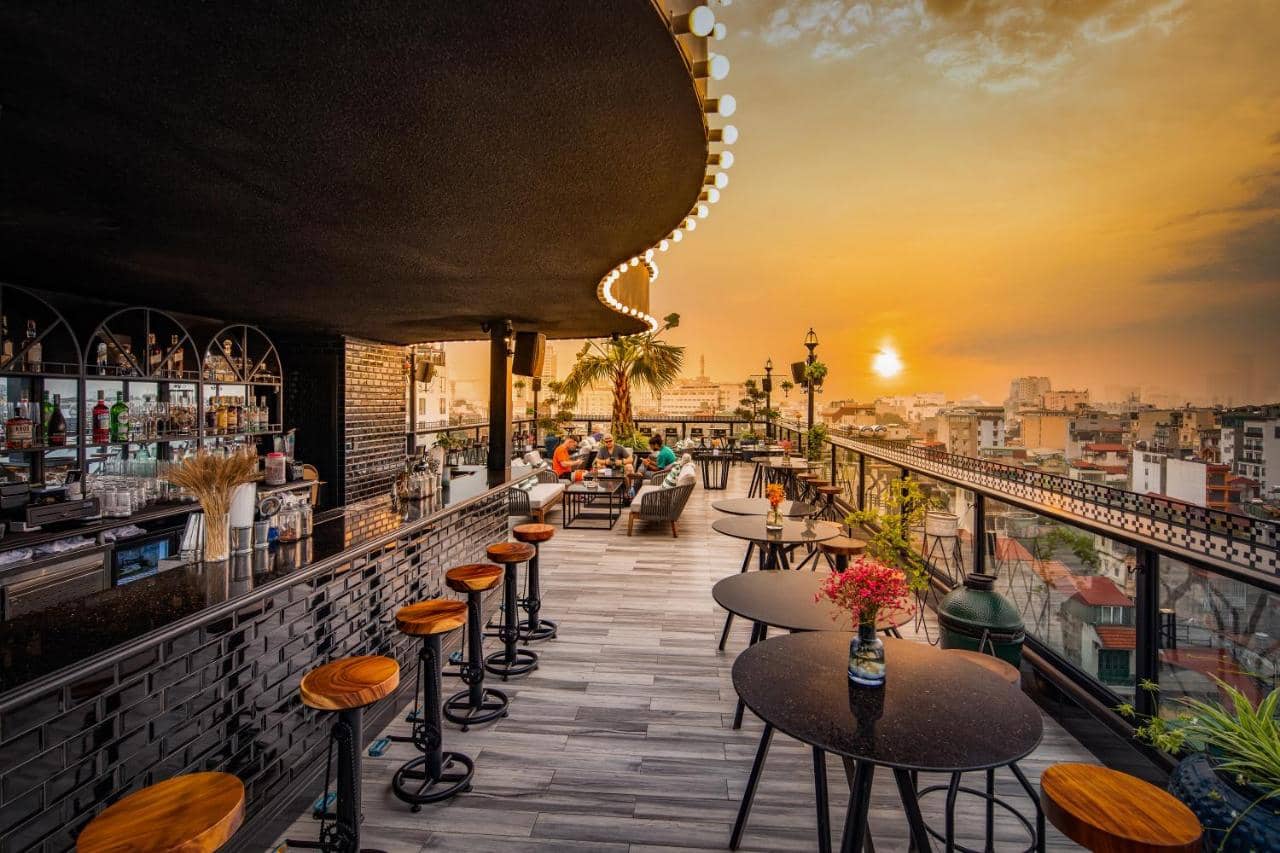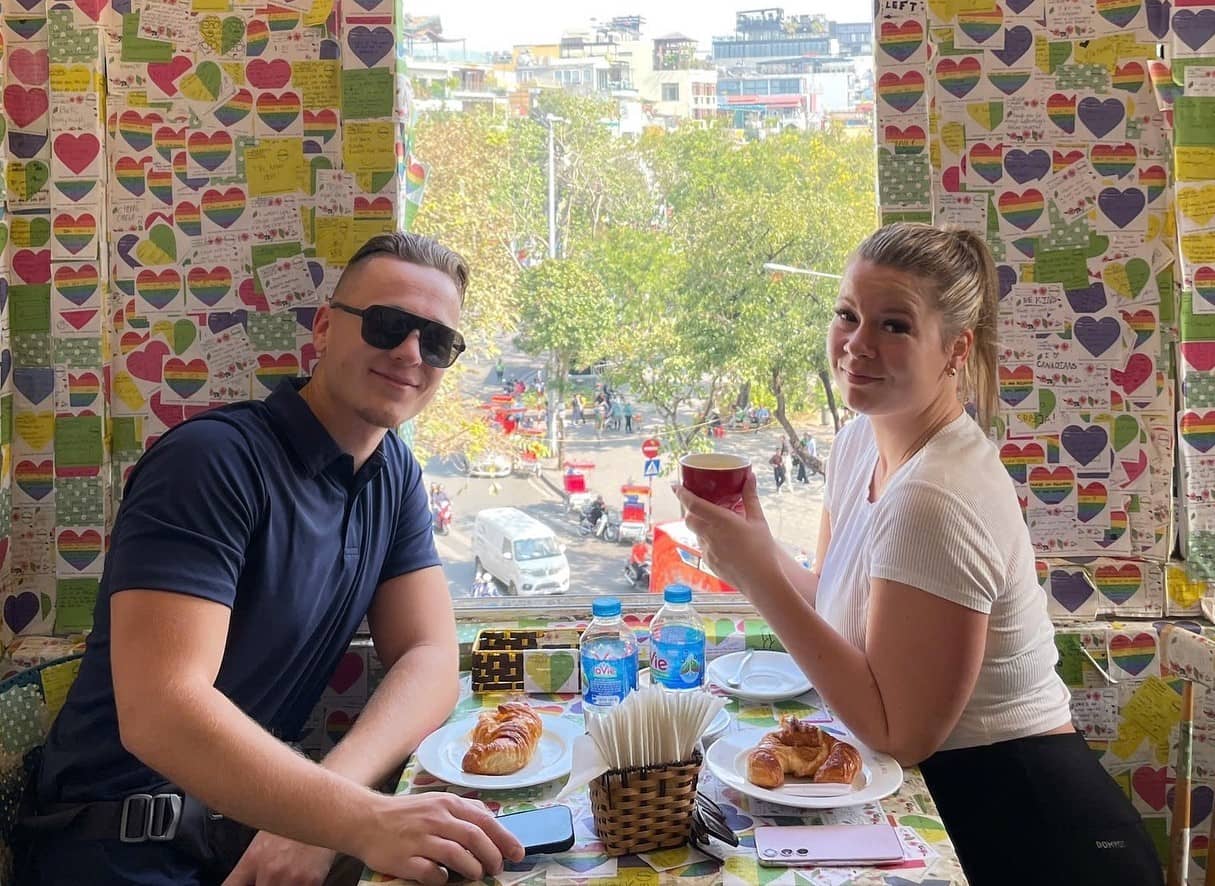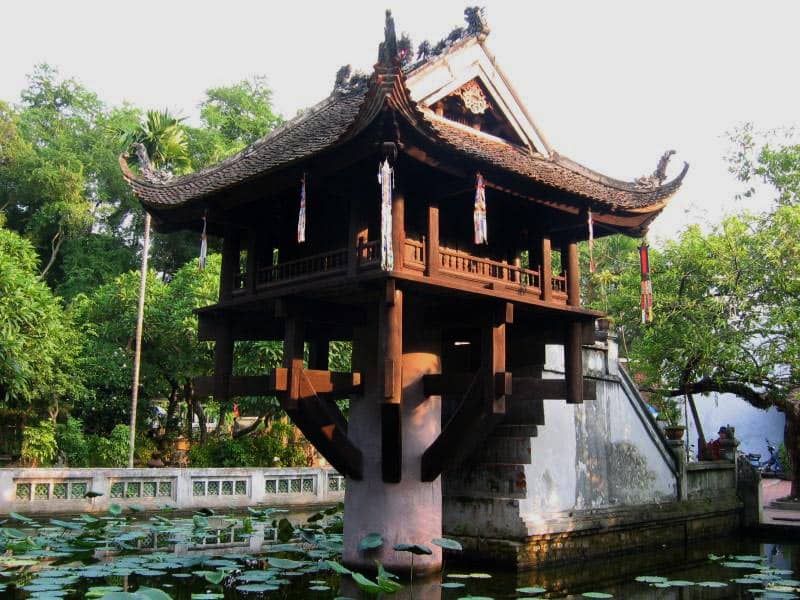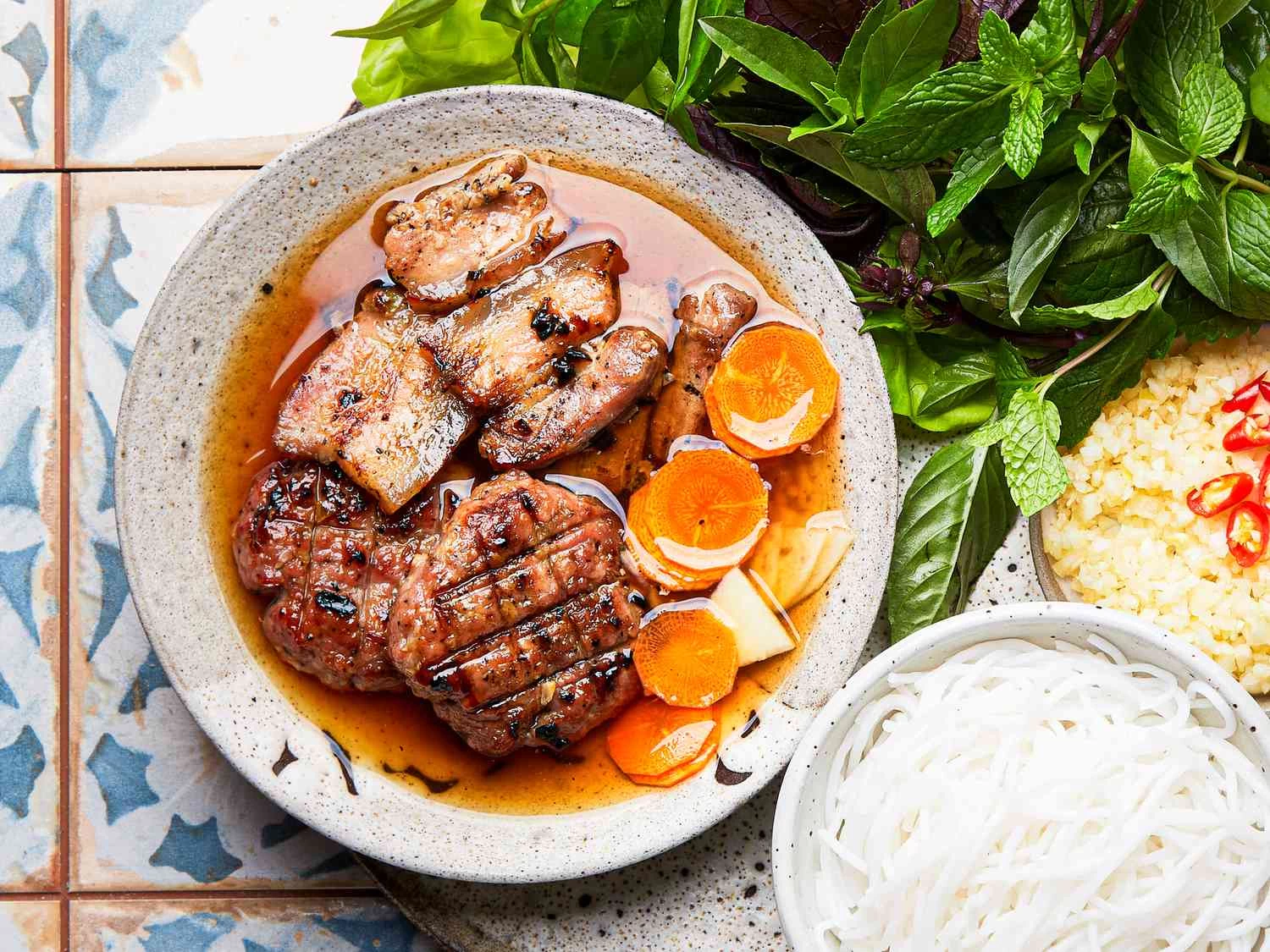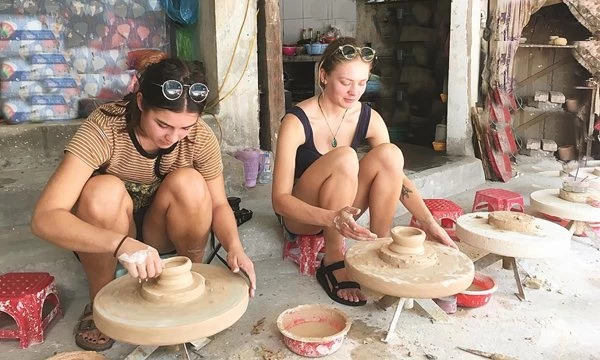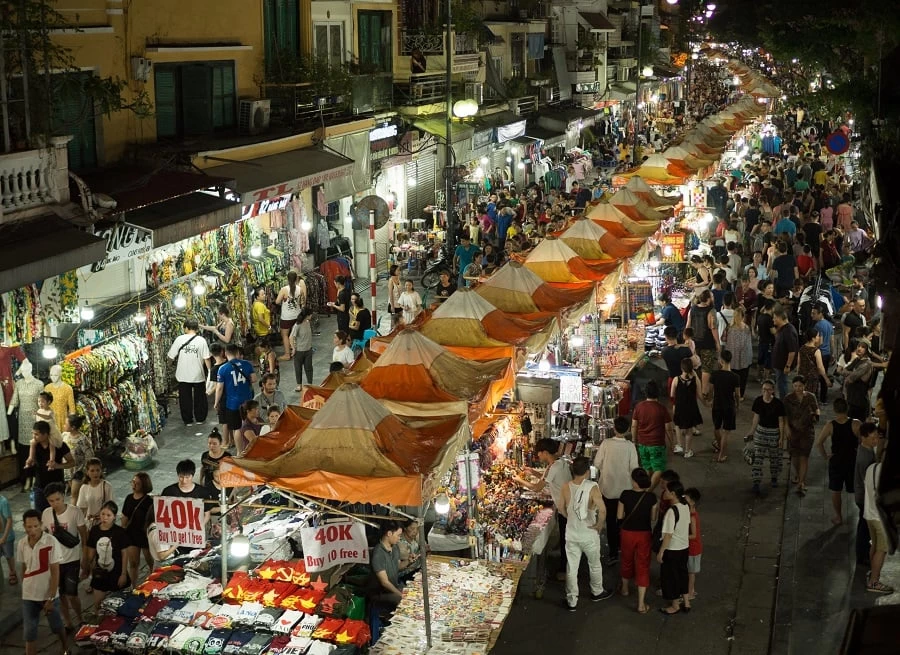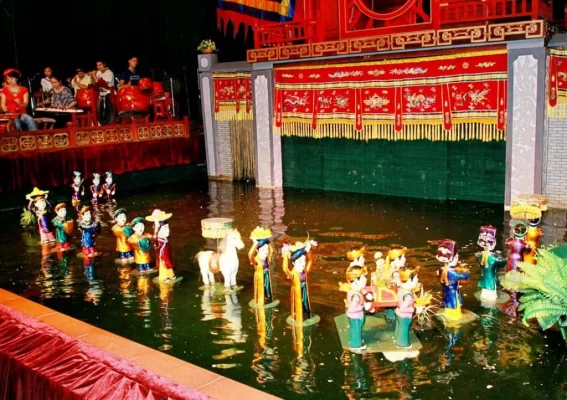
Water Puppetry is a unique art of Vietnam
Discover the captivating world of Water Puppetry, a traditional Vietnamese art form that combines live music, folklore, and intricate puppets to create a unique cultural experience. Perfect for international travelers seeking to explore Vietnam’s rich cultural heritage. Find out more about show times, tickets, and the historical significance of this enchanting art form with Ula Travel today!
I. Introduction to Water Puppetry
1. What is Water Puppetry?
Water puppetry is a unique and traditional form of Puppet theater that originated in Vietnam. This distinctive art form is performed in a waist-deep pool of water, with the puppeteers hidden behind a screen and using long bamboo rods to control the puppets.
The water serves not only as a stage but also as an essential element that brings the performances to life, creating a mesmerizing visual effect as the puppets appear to glide and dance on its surface.
2. When did water puppetry exist?
Water puppetry dates back to the 11th century, originating in the Red River Delta region of northern Vietnam. This art form was initially a form of folk entertainment performed by villagers in flooded rice paddies during festivals and communal celebrations. Over time, it evolved from these humble beginnings into a highly sophisticated and celebrated art form.
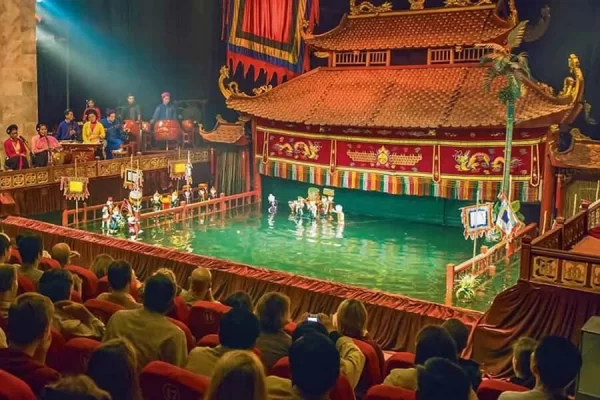
Water puppetry is an art of the Northern Delta
The early water puppet shows were closely tied to agricultural life and local folklore, depicting scenes from daily village life, harvests, and mythical tales. As water puppetry grew in popularity, it spread throughout the country, with each region contributing its own stories and stylistic elements. Despite its rural origins, it eventually found a place in urban centers and became an integral part of Vietnamese cultural heritage.
Click here: Hanoi Day Trip
3. The Role of Water Puppetry in Vietnamese Culture
Water puppetry holds a significant place in Vietnamese culture, symbolizing the creativity and resilience of the Vietnamese people. It is not merely a form of entertainment but a medium that reflects the values, traditions, and collective memory of the community.

Water puppetry shows the unique folk culture of Vietnam
The performances often incorporate themes of folklore, history, and social commentary, providing insight into the Vietnamese way of life and their connection to the natural world. Characters such as dragons, phoenixes, and farmers bring to life the myths and legends that have been passed down through generations.
Furthermore, water puppetry is recognized as a valuable cultural tradition that has been preserved through centuries of social and political change. It was listed as an intangible cultural heritage by UNESCO, highlighting its importance and the efforts to keep this unique art form alive for future generations.
Today, water puppetry continues to be a vibrant and dynamic part of Vietnam’s cultural landscape, attracting both local and international audiences. Performances are often accompanied by traditional Vietnamese music, including the use of drums, wooden bells, horns, bamboo flutes, and cymbals, creating an immersive cultural experience that resonates with viewers of all ages.
II. Interesting Things about Water Puppetry
1. The Water Puppetry Stage
Water puppetry is performed on a water stage, which is a unique feature that distinguishes it from other forms of puppetry. The stage, typically a large pool of water, represents the natural environment of the Vietnamese countryside, such as rice paddies, rivers, and lakes. The water serves not only as a dramatic backdrop but also as an essential element in the performance, creating a magical and mystical atmosphere.
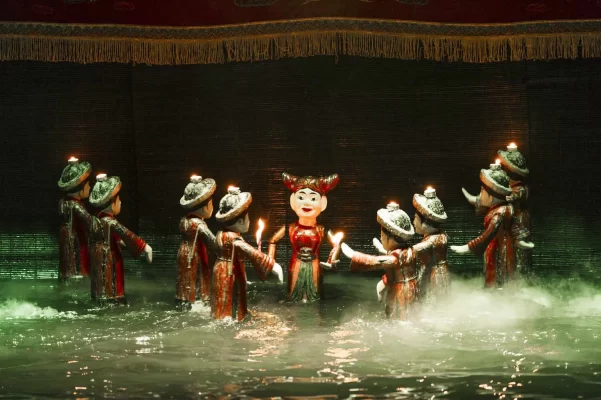
The water surface is the stage where water puppet shows take place
The puppeteers stand behind a screen, often made of bamboo and painted with traditional motifs, which conceals them from the audience. They manipulate the puppets using long bamboo rods and strings hidden beneath the water’s surface.
The water not only masks the puppeteers’ movements but also provides buoyancy, allowing the puppets to glide smoothly and appear as if they are truly alive and interacting with the environment.
2. Puppet Control Techniques
The puppets used in Water Puppetry are handcrafted from wood and meticulously painted with vibrant colors. Each puppet is designed to represent characters from Vietnamese folklore, mythology, and everyday life, including farmers, fishermen, mythical creatures, and historical figures.
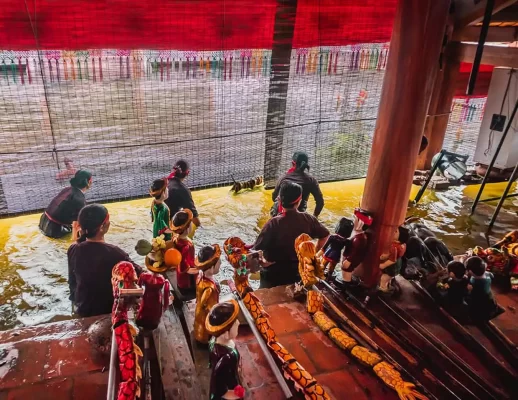
The water puppeteers always stand behind the curtain
The manipulation of these puppets requires considerable skill and practice. Puppeteers control the puppets from behind the screen using a system of bamboo rods and strings.
These rods are connected to the puppets through a complex mechanism that allows for a wide range of movements. The puppeteers’ dexterity enables the puppets to perform various actions such as swimming, dancing, fishing, and even fighting.
The art of puppet manipulation is often passed down through generations, with techniques and secrets being closely guarded within families or troupes. The seamless coordination and precision of the puppeteers bring the stories to life, captivating audiences with their intricate and lifelike performances.
3. Content of the Performances
Water puppetry performances are composed of short skits that typically last about 5–10 minutes each. These skits are inspired by Vietnamese rural life, historical events, legends, and folktales. Some of the most popular performances include:
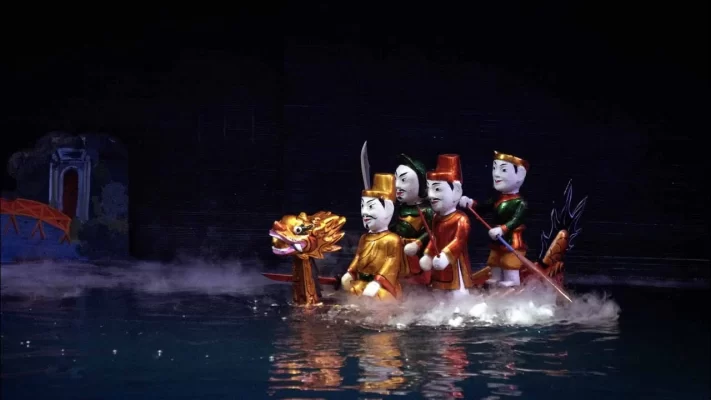
The Legend of the Restored Sword
- The Legend of the Restored Sword (Hoan Kiem Lake): This story tells the tale of King Lê Lợi, who was given a magical sword by the gods to drive out foreign invaders. After his victory, a giant turtle emerged from the lake and reclaimed the sword, returning it to the gods.
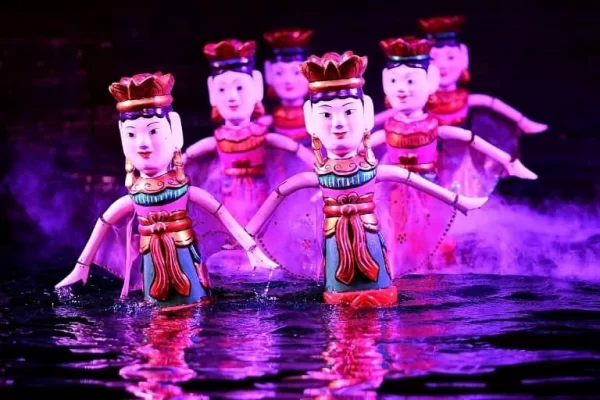
The Dance of the Fairies
- The Dance of the Fairies: A graceful performance depicting fairies dancing and playing in the water, showcasing the elegance and beauty of traditional Vietnamese aesthetics.
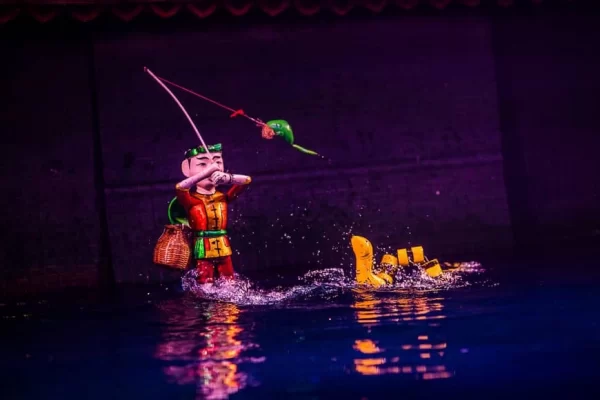
Fishing Scenes
- Fishing Scenes: These skits depict the everyday activities of Vietnamese fishermen, highlighting the close relationship between the people and their natural environment.
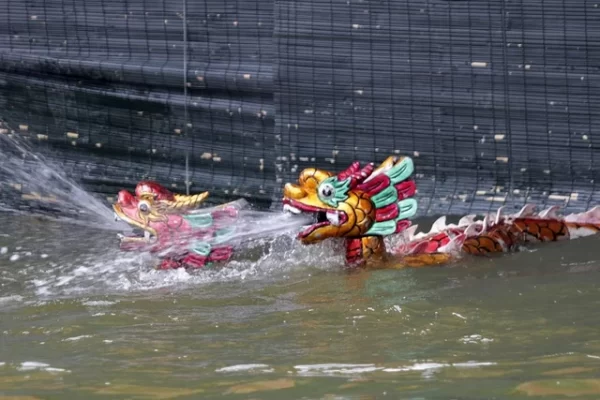
The Dance of the Dragon and Phoenix
- The Dance of the Dragon and Phoenix: This dramatic performance features two mythical creatures, the dragon and the phoenix, symbolizing prosperity and harmony. The intricate movements and interactions between the two puppets are a testament to the puppeteers’ skill.
Each performance is accompanied by traditional Vietnamese music, played on instruments such as the monochord zither, two-stringed fiddle, and various percussion instruments. The music enhances the storytelling, creating an immersive experience that transports the audience into the heart of Vietnamese culture.
III. Where to Experience Water Puppetry
Water puppetry is a unique and captivating traditional Vietnamese art form that offers a fascinating glimpse into the country’s rich cultural heritage. For international visitors, experiencing a water puppet show is an unforgettable highlight of any trip to Vietnam.
1. Thang Long Water Puppet Theater
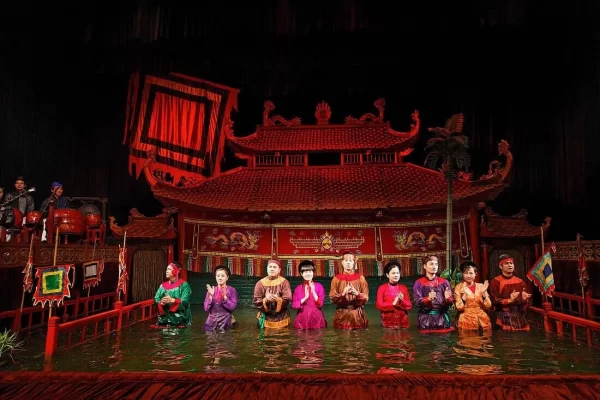
Thang Long Water Puppet Theater
The Thang Long Water Puppet Theater is one of the most famous venues for traditional Vietnamese water puppetry. Located in Hanoi’s Old Quarter, this theater offers a captivating experience where the ancient art form comes to life.
Performances at the Thang Long Theater feature beautifully crafted puppets, traditional music, and intricate water-based stage settings that depict various aspects of Vietnamese folklore and rural life.
Address: 57B Dinh Tien Hoang Street, Hoan Kiem District, Hanoi, Vietnam.
Show Schedule:
- Summer: 4:10 PM, 5:20 PM, 6:30 PM, 8:00 PM
- Winter: 3:00 p.m., 4:10 p.m., 5:20 p.m., 6:30 p.m., 8 p.m., 9:15 p.m.
- Sunday: 9:30 a.m.
- Each Thang Long water puppet show will last about 45 minutes.
Ticket Price: Prices range from approximately 100,000 to 200,000 VND (about $4.50 to $9.00 USD) per person, depending on seat location and time of day.
2. Vietnam Puppet Theater
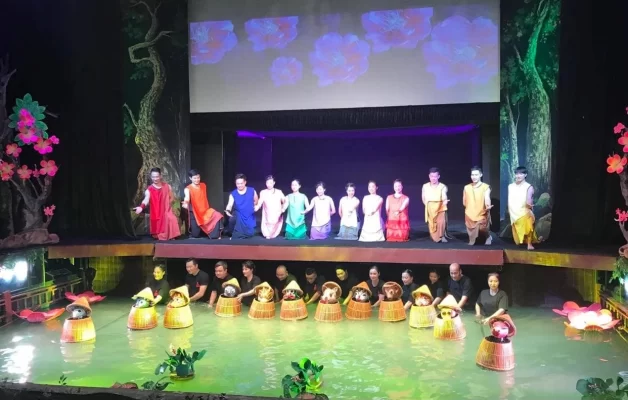
Vietnam Puppet Theater
The Vietnam Puppet Theater offers another excellent venue for experiencing this unique cultural performance. The theater showcases traditional Vietnamese water puppetry with a focus on historical and mythical themes, using an elaborate water stage and live orchestra.
- Address: 61 Truong Chinh, Khuong Trung, Thanh Xuan, Hanoi
- Show Schedule: Shows are conducted daily, usually starting at 2:00 PM, 4:00 PM, and 8:00 PM. It’s recommended to confirm the schedule before visiting.
- Ticket Price: Tickets are priced around 80,000 VND to 100,000 VND (about $3.5 to $5 USD) per person. Premium seating may be available at higher prices.
3. Bong Sen Water Puppet Theater
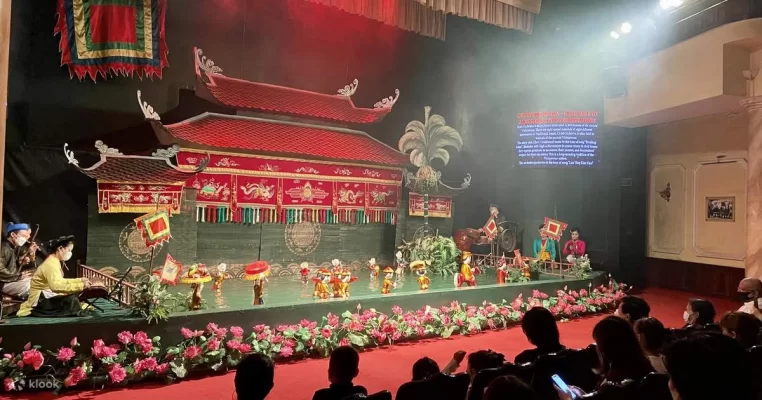
Bong Sen Water Puppet Theater
Located in the heart of Hanoi, the Bong Sen Water Puppet Theater is renowned for its high-quality performances that blend traditional puppetry with modern theatrical elements. The theater provides an immersive experience with vibrant puppetry performances that reflect the rich cultural heritage of Vietnam.
- Address: No. 16 Le Thai To, Hang Trong, Hoan Kiem, Hanoi.
- Show Schedule: Shows are conducted daily, usually starting at 2:45 PM, 3:30 PM, 4:00 PM, 5:15 PM, and 6:30 PM. It’s recommended to confirm the schedule before visiting.
- Ticket Price: The cost of tickets generally falls between 80,000 VND and 100,000 VND (about $3.5 to $5 USD) per person. Different seating options may be available.
IV. Cultural Significance of Water Puppetry
1. Cultural Connection
Water puppetry is an enchanting traditional Vietnamese art form that offers an immersive glimpse into the cultural heritage of Vietnam. This unique performance art connects visitors with Vietnam’s rich folklore and historical narratives, providing a vivid portrayal of local traditions and beliefs.
- Reflecting Vietnamese Traditions: Water Puppetry serves as a living archive of Vietnam’s agrarian past. Originating in the Red River Delta, this art form was initially performed in village ponds and rice fields, making use of water as both a stage and a thematic element. The puppets themselves often represent rural life, including scenes of farming, fishing, and daily village activities, offering visitors an authentic representation of traditional Vietnamese life.
- Mythical Tales and Legends: The performances frequently incorporate local myths and legends, bringing ancient Vietnamese stories to life. Through intricate puppetry and water-based staging, audiences are introduced to characters from folklore, such as dragons, fairies, and gods, thus gaining insight into the spiritual and mythological dimensions of Vietnamese culture.
- Community and Rituals: Water puppetry also reflects the communal spirit of Vietnamese culture. Traditionally, these performances were communal events held during festivals and celebrations, reinforcing social bonds and collective identity. By engaging with this art form, visitors can appreciate the importance of community and festivity in Vietnamese society.
- Artistic Expression and Craftsmanship: The artistry involved in creating and manipulating the puppets showcases the skill and creativity inherent in Vietnamese craftsmanship. Each puppet is meticulously handcrafted, often adorned with vibrant colors and intricate designs that represent various characters and themes. The performance itself, with its blend of music, dance, and dramatic storytelling, demonstrates the rich artistic heritage of Vietnam.
2. Cultural Heritage
Water puppetry is not only a cultural treasure but also a vital component in the preservation of Vietnam’s intangible cultural heritage. Its significance extends beyond entertainment, playing a crucial role in maintaining and transmitting cultural practices across generations.
- Preserving Traditional Techniques: Water puppetry embodies traditional techniques that have been passed down through generations. The knowledge and skills required to create and perform water puppetry are carefully preserved by dedicated artisans and performers. This ongoing tradition ensures that these ancient techniques remain vibrant and relevant, despite the pressures of modernization.
- Educational Value: By showcasing historical and cultural narratives through performance, water puppetry serves as an educational tool. It helps both locals and tourists understand and appreciate Vietnam’s rich cultural tapestry. Educational programs and performances at cultural centers and museums also play a role in teaching the next generation about the significance of this art form.
- Cultural Diplomacy: On the international stage, Water Puppetry acts as a cultural ambassador for Vietnam. By presenting this unique art form to global audiences, Vietnam fosters cultural exchange and promotes a deeper understanding of its heritage. Water puppet performances are often featured in cultural festivals and international arts events, highlighting the country’s rich artistic legacy.
- Cultural Revitalization: The continued popularity and support for water puppetry contribute to its revitalization and sustainability. Efforts to modernize the art form while retaining its traditional essence ensure that it remains an integral part of Vietnam’s cultural landscape. This balance between innovation and tradition helps preserve the art form for future generations.
Learn more about: Hanoi Culture
V. Visiting Water Puppet-Making Village
Water puppetry is an enchanting art form deeply rooted in Vietnamese culture, and understanding its craftsmanship offers a unique glimpse into its rich heritage. Visiting traditional puppet-making village provides an immersive experience where you can witness firsthand how these intricate puppets are made and learn about the traditional methods passed down through generations.
1. Dao Thuc Water Puppet Village (Hanoi)
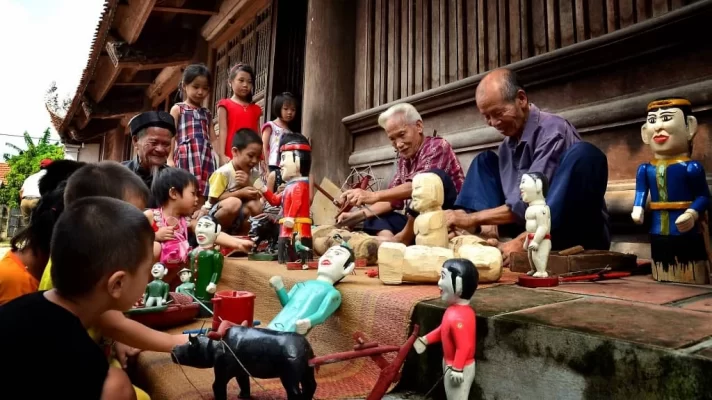
Dao Thuc Water Puppet Village
Dao Thuc Water Puppet Village is one of the most renowned traditional craft villages in Vietnam, famous for its centuries-old tradition of making water puppets. The village has been producing these intricate puppets for over 300 years, maintaining the unique art form passed down through generations.
Artisans in Dao Thuc meticulously handcraft each puppet, ensuring that every piece reflects the rich cultural heritage of Vietnam. The puppets are typically made from fig wood, which is lightweight and durable, and are intricately painted with vibrant colors to bring the characters to life.
Dao Thuc Water Puppet Village is located in Thuy Lam Commune, Dong Anh District, about 20 kilometers northeast of Hanoi. The village is easily accessible from the city, making it a convenient day trip for tourists interested in exploring traditional Vietnamese crafts.
2. Experiences at Dao Thuc Water Puppet Village
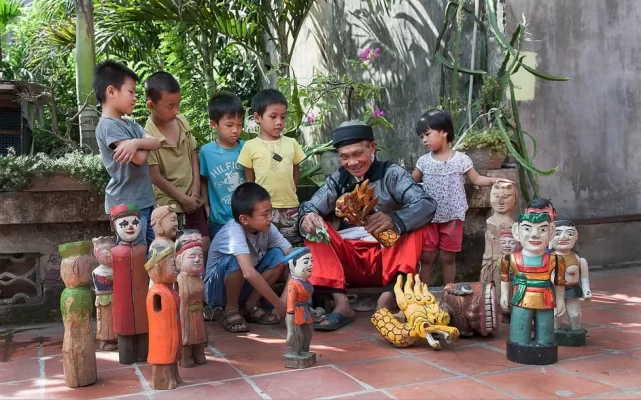
This unique art is still preserved through generations of the village
Visiting Dao Thuc Water Puppet Village offers a unique opportunity to delve into the world of traditional Vietnamese water puppetry and to witness the intricate process of puppet-making firsthand. Here are some of the highlights:
Puppet-Making Workshops:
- Visitors can participate in workshops where they learn about the different stages of creating a water puppet, from carving the wood to painting and decorating.
- Experienced artisans guide participants through the process, offering hands-on experience and a deeper appreciation for the craftsmanship involved.
Traditional Performances:
- The village hosts water puppet shows in its traditional performance space. These shows feature various folk tales, legends, and scenes from rural life, accompanied by live music played on traditional Vietnamese instruments.
- Visitors can enjoy the performances and see the puppets in action, understanding how they are manipulated by the puppeteers from behind a screen.
Cultural Immersion:
- Engaging with the local artisans provides insight into the village’s history and the significance of water puppetry in Vietnamese culture.
- Visitors have the chance to explore the village, interact with locals, and learn about their daily lives and the preservation of their craft.
Souvenir Shopping:
- The village offers a variety of handmade water puppets and other traditional crafts for sale. These make for unique and meaningful souvenirs, each with its own story and connection to Vietnamese heritage.
VI. Travel Tips for Visitors
- Book in advance: Water puppet shows are popular among tourists and locals alike, so it is advisable to book your tickets in advance to secure your preferred showtime and seating.
- Arrive Early: Arriving at least 15–30 minutes before the show starts allows you to get settled, explore the venue, and avoid any last-minute rush.
- Dress Comfortably: The temperature inside the theater can vary, so dressing in layers is a good idea. Also, as the show is performed on a water stage, there’s no need to worry about getting wet.
- Respect local customs: Remember to turn off or silence your mobile phones during the performance. Photography and filming may be restricted during the show, so be sure to follow the theater’s guidelines.
- Enjoy the music and narration: Water puppet shows are accompanied by traditional Vietnamese music and live narration. While the dialogues are often in Vietnamese, the expressive movements of the puppets and the music will provide a rich understanding of the performance.
- Ask for English translations: Some theaters provide English subtitles or program notes. If you’re not fluent in Vietnamese, check if these are available to enhance your understanding of the stories being portrayed.
In summary, Water Puppetry stands as a testament to Vietnam’s rich cultural legacy and artistic ingenuity. For anyone exploring Vietnam, attending a water puppet show is an unforgettable experience that promises to enhance your understanding and appreciation of the country’s diverse cultural tapestry. We highly encourage you to include this extraordinary performance in your travel itinerary and immerse yourself in the magic of Vietnamese water puppetry.
See more: Hanoi travel tips



